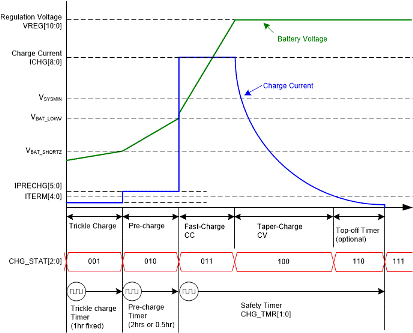ZHCSNY0B May 2020 – January 2023 BQ25798
PRODUCTION DATA
- 1 特性
- 2 应用
- 3 说明
- 4 Revision History
- 5 说明(续)
- 6 Device Comparison
- 7 Pin Configuration and Functions
- 8 Specifications
-
9 Detailed Description
- 9.1 Overview
- 9.2 Functional Block Diagram
- 9.3
Feature Description
- 9.3.1 Device Power-On-Reset
- 9.3.2 PROG Pin Configuration
- 9.3.3 Device Power Up from Battery without Input Source
- 9.3.4 Device Power Up from Input Source
- 9.3.5 Dual-Input Power Mux
- 9.3.6 Buck-Boost Converter Operation
- 9.3.7 USB On-The-Go (OTG)
- 9.3.8 Power Path Management
- 9.3.9 Battery Charging Management
- 9.3.10 Integrated 16-Bit ADC for Monitoring
- 9.3.11 Status Outputs ( STAT, and INT)
- 9.3.12 Ship FET Control
- 9.3.13
Protections
- 9.3.13.1
Voltage and Current Monitoring
- 9.3.13.1.1 VAC Over-voltage Protection (VAC_OVP)
- 9.3.13.1.2 VBUS Over-voltage Protection (VBUS_OVP)
- 9.3.13.1.3 VBUS Under-voltage Protection (POORSRC)
- 9.3.13.1.4 System Over-voltage Protection (VSYS_OVP)
- 9.3.13.1.5 System Short Protection (VSYS_SHORT)
- 9.3.13.1.6 Battery Over-voltage Protection (VBAT_OVP)
- 9.3.13.1.7 Battery Over-current Protection (IBAT_OCP)
- 9.3.13.1.8 Input Over-current Protection (IBUS_OCP)
- 9.3.13.1.9 OTG Over-voltage Protection (OTG_OVP)
- 9.3.13.1.10 OTG Under-voltage Protection (OTG_UVP)
- 9.3.13.2 Thermal Regulation and Thermal Shutdown
- 9.3.13.1
Voltage and Current Monitoring
- 9.3.14 Serial Interface
- 9.4 Device Functional Modes
- 9.5 Register Map
- 10Application and Implementation
- 11Power Supply Recommendations
- 12Layout
- 13Device and Documentation Support
- 14Mechanical, Packaging, and Orderable Information
9.3.9.2 Battery Charging Profile
The device charges the battery in five phases: trickle charge, pre-charge, constant current, constant voltage, and top-off trickle charging (optional). At the beginning of a charging cycle, the device checks the battery voltage and regulates current/voltage accordingly.
| VBAT | CHARGING CURRENT | REGISTER DEFAULT SETTING | CHRG_STAT |
|---|---|---|---|
| < VBAT_SHORT | IBAT_SHORT | 100 mA (fixed value) | 001 |
| VBAT_SHORTZ to VBAT_LOWV | IPRECHG | 120 mA | 010 |
| > VBAT_LOWV | ICHG | 1 A | 011 |
If the charger is in DPM regulation or thermal regulation during charging, the actual charging current is less than the programmed value. In this case, termination is temporarily disabled and the charging safety timer is counted at half the clock rate, as explained in GUID-68705BC8-F1E0-41D7-AE02-1C4CAA98EA77.html.
During SYSMIN regulation with BATFET LDO operation, the charge current is limited to 2 A maximum, regardless of the charge current register setting being set higher than 2 A, in order to protect the BATFET. It is not recommended to set the battery regulation voltage lower than the SYSMIN regulation voltage. The BATFET LDO operation can be disabled by setting DIS_LDO = 1. In this state, charge current is regulated according to #GUID-9EDEEE87-AD91-4421-888C-DD5DCE3C4139/T4885767-79 and SYS voltage is V(BAT) plus the IR drop through the BATFET, regardless of battery voltage. No VSYSMIN is maintained. Note that, when in trickle charge, setting DIS_LDO = 1 does not affect IBAT_SHORT.
VBAT_SHORTZ is the battery voltage threshold for transition from trickle charge to precharge, which is fixed at 2.25V typical. During the trickle charge to precharge transition, the charger regulates the battery voltage to 2.5V/cell typical for tBAT_SHORTZ duration. VBAT_LOWV is the battery voltage threshold for the transition from precharge to fast charge. It is defined as a ratio of battery voltage regulation limit (VREG).
 Figure 9-10 Battery Charging
Profile
Figure 9-10 Battery Charging
Profile